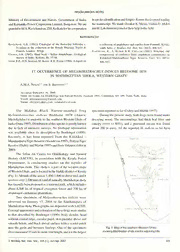
Occurrence of Melanobatrachus Indicus Beddome 1878 in Mathikettan Shola, Western Ghats PDF
Preview Occurrence of Melanobatrachus Indicus Beddome 1878 in Mathikettan Shola, Western Ghats
MISCELLANEOUS NOTES Ministry of Environment and Forests, Government of India, inspeciesidentificationandSanjeevKumarJhaforproofreading andKarnatakaPowerCorporationLimited,Bangalore.Weare themanuscript.WethankDivakarK. Mesta,Vishnu D. Mukri gratefultoM.S.Ravichandran,ZSI,Kolkataforhiscooperation andH.Lakshminarayanafortheirhelpinthefield. REFERENCES Boulenger, G.A. (1882): Catalogue of the Batrachia Salientia s. acollection ofamphibiansand reptilesfromPonmudi, Kerala, Ecaudata in the collection of the British Museum. Taylor & south India. J. Bombay Nat. Hist. Soc. 81(2): 406-427. Francis, London. 503pp. Vasudevan, K., A. Kumar & R. Chellam (2001): Structure and Chanda, S.K. (2002): Hand book - Indian Amphibians. Zoological composition of rainforest floor amphibian communities in Survey ofIndia. Kolkata. Pp. 57-58. Kalakkad-Mundanthurai Tiger Reserve. Carr. Sci. 80(3): Inger, R.F., H.B.Shaffer,M. Koshy & R. Bakde(1984):Areporton 406-412. 17. OCCURRENCE OF MELANOBATRACHUS INDICES BEDDOME 1878 IN MATHIKETTAN SHOLA, WESTERN GHATS' A.M.A. Nixon2-3 and S. Bhupathy2-4 ‘Accepted September 10, 2004 “Salim Ali Centre for Ornithology and Natural History, Anaikatti (PO), Coimbatore 641 109, Tamil Nadu, India. “Email: [email protected] JEmail: [email protected], [email protected] The Malabar Black Narrow-mouthed Frog specimenreportedsofar(DaltryandMartin 1997). Melanobatrachus indicus Beddome 1878 (Anura: During the present study,both frogswerefound under Microhylidae) is endemic to the southern Western Ghats of decaying wood. The surroundings had thick leaf litter and India(Dutta 1997).Distributionofthisspeciesispoorlyknown canopy cover (> 80%), and a perennial stream was found due to lack of intensive surveys. No firsthand information about 200 m away. All the reported M. indicus so far have was available since its description by Boulenger (1890). Recently, it has been reported from the Kalakkad - MundanthuraiTigerReserve(Vasudevan 1997),PeriyarTiger Ar Reserve(Daltryand Martin 1997)andfromValparai (Ishwar X f ^cxfx *esf 2000 ). The Salim Ali Centre for Ornithology and Natural :Irj '* 1,. > History (SACON), in association with the Kerala Forest : *v Department, is conducting studies on the reptiles of (3 Mathikettan shola. This shola is a part ofthe western slope Jm?V ofWesternGhats,andislocatedintheIdukkidistrictofKerala Itf / rr'.L;" (Fig. 1).Altitudeoftheareais 1,400-1,800mabovemsl,andit ) X***1A '"fJ® receivesover2,500mmofrainfallannually.Mathikettanshola I frtt*-* T*?.spmwr 1 te,,,;# hasrecentlybeenproposedasanationalpark,whichincludes m about 6,500 ha of tropical evergreen forest and 700 ha of j$ abandoned cardamom plantations. •(Jk Two specimens of Melanobatrachus indicus were tf\" observed on January 17, 2004 in the Santhampara of \ Mathikettan shola. Photographsaredepositedwith SACON. Externalappearanceandcolorationofthesefrogsweresimilar hMt-kkM MmA .aTig<-> 1 x. to that described by Boulenger (1890): body slender, head X withoutcranialridge,circularpupil, skin pustularaboveand smooth below, and black dorsal surface with a scarlet patch near the groin and between forelegs. One ofthe specimens Fig. 1: MapofthesouthernWesternGhats (live)measured33mminsnout-ventlength,anditisthelargest showingMathikettansholaandtheadjoininghills J. Bombay Nat. Hist. Soc., 104 (1), Jan-Apr 2007 105 : : MISCELLANEOUS NOTES beensightedwithinfive metresofperennial streams (Daltry available for this species since its description (Daltry and and Martin 1997; Ishwar 2000). The present observation Martin 1997; Vasudevan 1997; Ishwar 2000), which is the reveals that this species may also occur a considerable second forthe Western Ghats ofKerala. distance away from water. The altitude of this locality was 1,450 m msl, and all previous sightings ofM. indicus were ACKNOWLEDGEMENTS within 1,000-1,500m.Thisindicatestherestricteddistribution of this species with respect to altitude. Though the present WethankJamesZacharias,WildlifeWarden,Eravikulam recordlieswithinthedistributionalrangeofthisspecies,lack NationalParkandtheDistrictForestOfficer,Munnarforlogistic of precise locality data makes the present observation supportinthefield.S.K.Dutta,UtkalUniversity,Bhubaneswar noteworthy. This is also one of the four reliable records offeredcommentsonanearlierdraftofthemanuscript. REFERENCES Boulenger, G.A. (1890): The Fauna of British India. Reptilia and India. 126 pp. Amphibia. Taylorand Francis, London, xvii + 541 pp. Ishwar, N.M. (2000): Melanobatrachus indicus Beddome, 1878, Daltry,J.C. &G.N. Martin(1997): Rediscoveryoftheblacknarrow- resightedattheAnaimalaiHills,southIndia.Hamadryad25(1): mouthed frog, Melanobatrachus indicus Beddome, 1878. 50-51. Hamadryad 22(1): 57-58. Vasudevan, K. (1997): Rediscovery of the black microhylid Dutta, S.K. (1997): AmphibiansofIndiaandSri Lanka(Checklist & (Melanobatrachus indicus). J. Bombay Nat. Hist. Soc. 94: Bibliography). Odyssey Publishing House, Bhubaneswar, 170-171. 18. NEW RECORD OF THE SIMPLE ASCIDIAN STYELA PLICATA (LESUEUR 1823)' V.K. Meenakshi2andS. SenthamaraT 'Accepted, December 29, 2004 ^Department of Zoology, A.PC. Mahalaxmi College for Women, Tuticorin 628 002, Tamil Nadu, India. Email: [email protected] ’Ameen Teacher Training Institute, Puthur, Somasipadi, Thiruvannamalai 606611, Tamil Nadu, India. — A simple ascidian Styelaplicata (Lesueur 1823) is plicata DeKay 1843, p. 259, Styela gyrosa: Heller 1877, reportedforthefirsttimefromTuticorinharbour,TamilNadu, p. 255,Styelagyrosa: Herdman 1882.p. 155,Styelaplicata India.OnlytwospeciesofthegenusStyelahavebeenreported Traustedt 1883a, p. 123, Styela plicata: Traustedt 1883b, earlierfromIndia(Renganathan 1981; Krishnanetal. 1989); p. 478, Styelaplicata: Traustedt 1885, p. 44, Styelapinguis: boththespeciesreported,StyelabicolorandStyelacanopus Herdman 1899, p.40, Tethyum plicatum: Hartmeyer 1909, , occurasfoulingorganismsinTuticorinandBombayharbour. p. 1359, Tethyumplicatum: Van Name, 1912, p. 569, Styela plicata: Huntsman 1912, p. 149, Styela plicata: Huntsman Styelaplicata (Lesueur 1823) Occurrence and distribution: Numerous specimens werecollectedfromtheshelteredwatersofTuticorinharbour (8° 48' N, 78° IT E), seen attached to piers, pilings, other harbour installations, corals and also from the pearl oyster cages suspended at a depth of4-5 m. This species has been previouslyreportedfromAustralia HartmeyerandMichaelsen ( 1928;Kott 1952, 1972a,b,c, 1975),HongKong(Tokiokaand Nishikawa 1975; Kott and Goodbody 1982), western Indian Ocean(Michaelsen 1918),Japan(Tokioka 1960),WestIndies (Van Name 1921, 1930, 1945), Atlantic Ocean and Mediterranean Sea (Harant 1927a, b; Harant and Vernieres 1933; Heller 1877) andeasterncoastofNorthAmerica(Van Name 1912;Huntsman 1912, 1913). Synonymy:AscidiaplicataLesueur 1823,p.5,Ascidia 106 J. Bombay Nat. Hist. Soc., 104 (1), Jan-Apr 2007
